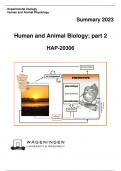Summary
Summary HAP20306: Human and Animal Biology; part 2
- Course
- Institution
- Book
This is a English summary of both parts EXAM A and EXAM B of the course HAP-20306: Human and Animal Biology, given in period 1 at the WUR. This is a thorough summary, including all lecture notes, practicals and also the imporant parts highlighted, including things asked at practice exams. There a...
[Show more]




